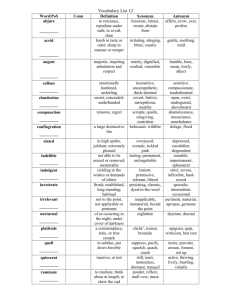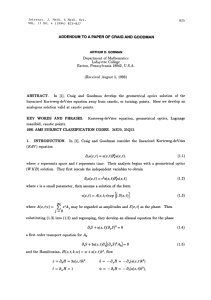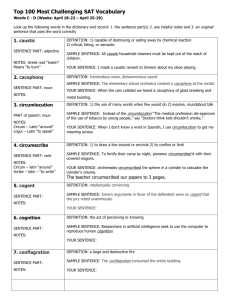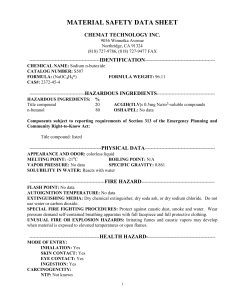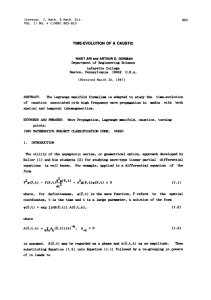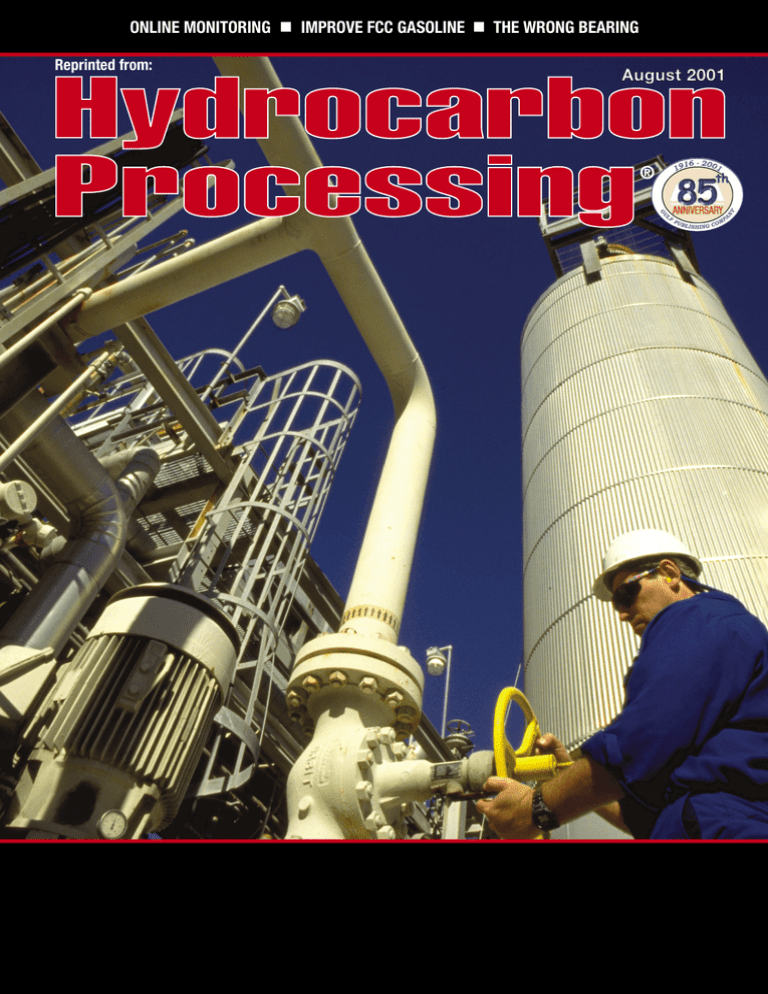
ONLINE MONITORING IMPROVE FCC GASOLINE THE WRONG BEARING
Reprinted from:
August 2001
This refinery used advanced coalescer techniques to separate very stable
emulsions and dispersions by mechanical means
A. Katona, Mol-RT Refinery, Szazhalombatta,
Hungary; T. Darde, Pall Europe, Saint Germainen-Lage, Cedex, France; and T. H. Wines, Pall
Corp., East Hill, New York
austic carryover from a treater can cause
downstream contamination of fluid catalytic
cracked (FCC) gasoline; Result: offspecification product. Caustic forms a very stable
emulsion with gasoline that results in high levels of
sodium, water and phenols in the final product. New
developments in coalescing technology have made it
possible to separate very stable emulsions and
dispersions.
In the following case history, the Mol-RT’s Szazhalombatta Refinery experienced emulsion problems
from caustic carryover. Eager to resolve this condition, refinery engineers investigated several technologies to break the emulsion and mitigate the problem. One option considered was a new high-efficiency
fluoropolymeric liquid / liquid coalescer to optimize
the caustic treating system. This case history details
the benefits when using present and new separation
equipment to control gasoline emulsion problems.
C
mercaptans are extracted into the caustic and then
converted to disulfide oils by oxidation and catalytic action. Also, phenols are extracted into the
caustic phase. The reactor effluent flows to a threephase separator where air, disulfides and regenerated caustic are separated. Regenerated caustic
is recycled back to the reactor. Fig. 1 shows a simplified schematic of the caustic-treating unit. The
process parameters for the Mol-RT Refinery caustic treater are presented in Table 1.
The reactor effluent contained a quantity of carried-over caustic that resulted in hazy gasoline product, high costs for caustic makeup and corrosion of
downstream piping. However, the hazy gasoline was
problematic. It had to be blended off or reprocessed;
otherwise, it would cause the final product to be
off-specification for sodium. Likewise, the carryover caustic could also react with methyl tertiary
butyl ether (MTBE) that was blended into the gasoline downstream of the caustic-treating system.
SEPARATION OPTIONS
To reduce the caustic excursions downstream
of the treating unit, Mol-RT considered several options,
which include settling
Caustic problems. The
tanks, mesh-pad beds,
Mol-RT Refinery in Sza- Table 1. Caustic treater process parameters.
electrostatic separators,
zhalombatta, Hungary,
sand beds and water
Application
Removal of caustic from gasoline
operates a caustic-treatwashing:
130 m3/h (19,624 bpd)
ing unit to remove mer- Process flowrate
Settling tanks were
Temperature
40°C (104°F)
captans from FCC gaso- Pressure
deemed not viable due to
6.5 barg (94.3 psig)
line. This unit processes Gasoline viscosity
the high stability of the
0.55 centistokes @ 38°C
130 m3/ h (19,624 bpd) of Gasoline density
caustic-fuel emulsion. A
0.68 g/ml
FCC gasoline. In this Caustic density
stable emulsion contains
1.02 g/ml
12.4 dyne/cm
process, FCC gasoline is Interfacial tension
very small droplets that
12.4
delivered to two f ixed- Caustic water pH
do not settle efficiently,
< 1 ppmw
bed reactors, each con- Total suspended solids
and excessive settling
taining
a
catalyst Injected caustic concentration 3° Baumé (2.3 % wt)
time and /or tank volume
would be required.
impregnated onto an
Mesh pads operate
activated carbon subby the principle of inertial impaction whereby the
strate. Cobalt and vanadium pthalocyanines are
droplet momentum is great enough so the droplet
used as catalysts due to their high activity and staleaves the streamlines of the fluid flow and impacts
bility in the oxidation reaction for mercaptans and
metal f ibers or plates in the mesh pads. These
low solubility in petroleum fuels. 1 Caustic (3°
droplets then coalesce into large drops that separate
Baumé) and oxidizing air are injected into the FCC
by gravity. Mesh pads do not work well when the
gasoline upstream of the reactor. In the reactor,
Reprinted from HYDROCARBON PROCESSING magazine, August 2001 issue, pgs. 103-108. Used with permission.
Process Technology—Refining
Improve haze removal for
FCC gasoline
carbon fuels by acting as coalescers
whereby the small caustic droplets
adsorb onto the sand and form larger
drops that are also separated by
gravity. In practice, however, sand
beds are prone to severe problems of
fluid channeling through the bed
caused by bed compaction and cracking. This often leads to poor sand bed
performance and high manpower
costs to load and unload the bed.
Water washing usually requires
large extraction towers that have a
high initial capital expense and additional separation equipment to
remove any carryover water from the
extraction process. This process consumes water that will require disposal or further treatment for re-use
after the extraction process.
Liquid/ liquid coalescers have
the same low operating costs regardless of the amount of water or caustic
charged to the unit. Based on the
superior efficiency and low cost of
separation, the Mol-RT Ref inery
decided to run field trials with highefficiency polymeric liquid/liquid
(L / L) coalescers.
Fig. 1. Caustic treating Unit at the Mol-RT Refinery.
L / L coalescer system. The traditional L / L coalescers have used
glass-fiber media, which work well
Interfacial tension,
for emulsions that have interfacial
dyne/cm
tensions greater than 20 dyne/cm
0.7
and for systems that have neutral
0.6
water as the dispersed phase. New
0.5
5.0
coalescer media, constructed with
3.9
novel formulated polymers and fluo4.3
ropolymers, are effective for emul3.6 – 4.7
sions having interfacial tensions as
0.8
low as 0.5 dyne/cm and for harsh
10.2
chemical environments such as the
2.4
caustic/ fuel system. 2,3 High-effi8.4
ciency polymeric coalescer have pro12.0
duced clean petroleum fuels with
12.4
sodium levels below 0.5 mg/l and free
water concentrations of <15 ppmv.
A high-efficiency L /L coalescer
in the horizontal configuration is shown in Fig. 2.
The system consists of a pre-filter section followed
by a horizontal coalescer cartridge stage with a settling zone that relies on the difference in density
for separation of the coalesced droplets. The fluid
enters at the side of the housing and flows from the
inside of the coalescer cartridges radially outward
causing the enlargement or coalescing of the inlet
dispersion into large droplets in the outlet stream.
These coalesced droplets then flow axially in the horizontal direction through a settling zone. The dispersed caustic-phase coalesced droplets settle downward by gravity and are collected in a sump located
at the bottom of the housing. Purified gasoline leaves
at the top of the housing.
Table 2. Caustic- fuel interfacial tension data gathered from field tests.
Plant location
Hydrocarbon
U.S. Pacific
U.S. Pacific
U.S. Midwest
U.S. Gulf Coast
U.S. Gulf Coast
U.S. Gulf Coast
Canada
Canada
Canada
Canada
Singapore
England
Hungary
Heavy catalytic cracked (HCC) gasoline
Light catalytic cracked (LCC) gasoline
Heavy catalytic cracked (HCC) gasoline
Fluid catalytic cracked (FCC) gasoline
Light gas oil (LGO)
Heavy catalytic naphtha (HCN)
Refined oil (RO)
Heavy catalytic naphtha (HCN)
Light catalytic naphtha (LCN)
Kerosine
Kerosine
Fluid catalytic cracked (FCC) gasoline
Fluid catalytic cracked (FCC) gasoline
interfacial tension is low (< 20 dyne /cm) and the
droplets are very small leading to poor droplet capture
efficiency. Also at flowrates reduced from the original
design, the inertial separation force is greatly lowered leading to poor separation.
Electrostatic precipitators separate caustic water
from hydrocarbons by mean of an electric charge created by a high voltage source. While electrostatic separators can be effective, they require a high operating
cost for electricity. Furthermore, they require significant
initial capital expenditures and can have high maintenance costs when electrodes short circuit due to caustic slugs (increased conductivity) or scale buildup on
the electrodes.
Sand beds are able to separate caustic from hydro-
HYDROCARBON PROCESSING / AUGUST 2001
The L /L coalescing system operates in three stages: separation of
solids, coalescence and separation of
coalesced drops:
Separation of solids. Solids
can increase the stability of an
emulsion; consequently, removing
solids can make coalescing easier.
Generally, this step can be achieved
by a separate cartridge filter system or by a re-generable backwash
f ilter system for high levels of
solids. In addition, the filtration
stage protects the coalescer and
increases service life.
Coalescence. The next step is
primary coalescence. In this stage,
the pore dimensions begin with a
very fine structure and then become
more open to allow for void space for Fig. 2. High-efficiency L/L coalescer system.
the coalescing droplets. In the primary coalescence zone, the inlet
Table 3. Pilot-scale L /L coalescer results.
droplet dispersion containing fine
droplets in the size range of 0.2 to 50
Flowrate,
Test
Volume of
Visual
Concentration of Caustic water
microns (m) is transformed into a
lpm
duration, caustic water appearance, caustic solution recovered, liters
suspension of enlarged droplets in
min
coalesced, liters inlet/outlet coalesced, ppmv caustic water/
the size range of 500 to 5,000 m.
m3 gasoline
The coalescence mechanism
5
50
0.74
Hazy/Clear
3,000
3.00
involves the adsorption of droplets
11
115
4.00
Hazy/Clear
3,162
3.16
to the coalescer fibers, followed by
20
120
7.15
Hazy/Clear
2,979
2.98
translation along the fibers and col23
1,405
64.63
Hazy/Clear
2,000
2.00
lisions at the junctures between
f ibers. In these collisions, the
droplets merge together or coalesce.
uid interface (coalescer fibers) or at the liquid / liquid
The viscous drag of the bulk fluid stream then causes
interface (water/oil).
the enlarged drops to disengage from the fibers. This
When surfactants concentrate on the coalescer
process is repeated a number of times through the
fibers, this is known as “disarming.” The coalescer
coalescer depth until the large coalesced drops exit
fibers are shielded from the passing aqueous droplets;
the coalescer media. The necessary condition that
this results in poor separation efficiency. Generally,
droplet-fiber adsorption occur for coalescing has been
the disarming phenomenon does not occur unless the
supported by many sources.4 ,5
interfacial tension between water and fuel is less than
Separation of coalesced droplets. Once the
20 dyne/cm. When specially formulated polymeric coadroplets have been coalesced, they are now assumed
to be as large as possible for given flow conditions. Seplescer medium was used in place of glass fiber, disaration is achieved by using a settling zone, which relies
arming was not observed.2 ,3 The coalescing perforon the difference in densities between the coalesced
mance of a polymeric medium can be greatly enhanced
droplets and bulk fluid. Caustic is separated in a colby modifying surface properties that can not be done
lection sump that can be manually drained on a periodic
with glass-fiber medium.
basis or equipped with an automatic level control and
Surfactants can also concentrate at the water/fuel
drain system. Estimation of the coalesced drop size
interface. This condition can lead to very small
and required settling zone is best determined through
droplets and stable emulsions. To separate these types
pilot-scale tests at field conditions.
of emulsions, special consideration must be directed to
the pore size and distribution in the coalescer media
Surfactants. They are naturally present in crude oil,
to intercept and coalesce these fine droplets. Field
and thus, are found in refined petroleum products.
tests conducted at caustic-treating units have uncovDuring the oxidation process and the caustic recircuered similar results showing very low interfacial tenlation in the sulfur-removal process, surfactants can be
sion of caustic- hydrocarbon emulsions as shown in
concentrated to high levels. Surfactants present in
Table 2.
caustic treaters include: sulfides, mercaptides, naphthenic acids, cresylic acids and phenol homologs. 6
Pilot-scale L/L coalescer test. To evaluate the sizPetroleum naphtha sulfonates have also been identiing and performance of the new fluoropolymeric coafied as natural occurring petroleum surfactants that
lescer to separate the carried-over caustic from the
are especially detrimental to glass-fiber conventional
FCC gasoline at the sulfur-removal system outlet, a
coalescers.7 The surfactants can adsorb at the solid /liqpilot-scale test coalescer unit was used at the Mol-RT
HYDROCARBON PROCESSING / AUGUST 2001
Fig. 3. Schematic of the pilot-scale L/L coalescer test unit.
Refinery. As shown in Fig. 3, it contained one 6-in.
(152.4-mm) length high-efficiency liquid / liquid test
coalescer and one 10-in. (254-mm) length pre-filter.
A slipstream was sent through the test unit, and the
quality of the influent and the effluent was analyzed.
If the effluent quality was acceptable, then the flow
through the unit was increased and the fluid quality
again analyzed. The flow through the test unit was
increased until the effluent quality was unacceptable.
In this case, the test was based on visual observations;
as long as the effluent was “bright and clear,” then the
flowrate was increased. The results of the testing are
summarized in Table 3.
In analyzing the data, the maximum flow that was
run through the test unit was 23 lpm (6.1 gpm). A
Karl Fischer total water analysis was conducted by
Mol-RT Refinery; results showed that the gasoline
at the outlet of the test coalescer had less than 15
ppmv of free water. The water concentrations measured were close to the water saturation value (251
ppmw @40°C) at the test flowrate of 23 lpm. It was
also found that when the gasoline from the coalescer
outlet was cooled to 5 ° C, it remained clear. The
amount of caustic water collected by the test coalescer was 2 liters of caustic solution per m 3 of gasoline (2,000 ppmv).
Data showed that the caustic/FCC-gasoline emulsion was a highly stable as indicated by the interfacial
tension measurement of 12.4 dyne /cm. Any emulsion
with an interfacial tension of less than 20 dyne /cm
is considered very stable and difficult to separate
using, settling tanks, mesh pads, sand beds or conventional glass-fiber coalescers. Based on the results
from the field tests at Mol-RT Refinery, the installation of high-efficiency fluoropolymeric liquid / liquid
(L / L) coalescers was recommended. The coalescer
would be intended to:
• Produce consistent “bright and clear” gasoline
• Recover caustic solution
• Reduce downstream corrosion
• Eliminate potential reaction of caustic with MTBE
blending.
Full-scale operation. Mol-RT installed a L / L coalescer system that contained 17 high-efficiency coalescer cartridges that were 40 in. in length and four in.
in diameter. A pre-filter was also installed to remove
solid particulates upstream of the coalescer. The sizing of the full-scale system was based on the pilot-scale
L / L coalescer tests and was at an equivalent flux to
14 lpm through the test coalescer. This was well below
the maximum test flowrate of 23 lpm and facilitated
possible variations in the caustic water properties that
may affect coalescing. The fluoropolymeric L / L coalescer cartridges were specially designed to remove
caustic carryover from hydrocarbon streams.
The coalescer unit was started up in November 1995.
After several months of operation, the following results
were observed:
• Approximately 2,000 ppmv of caustic solution
recovered by test coalescer (2 liter caustic/m 3 gasoline)
• No haze in effluent. Gasoline was “bright and
clear.” Samples were cooled to 5°C with no haze
observed.
The service life of the pre-filters was 6 months before
requiring change-out and the L / L coalescers operated
for 18 months. In this service, the service life for the
pre-filter and coalescers exceeded the initial design
requirements, and therefore, represented a low overall
operation expense.
HYDROCARBON PROCESSING / AUGUST 2001
Phenol removal. Another advantage detected in
the test was the removal of phenol. During tests, phenol concentration in the FCC gasoline was approximately 330 ppm in the coalescer influent. Because the
phenol is concentrated in the aqueous phase, the coalescer was able to reduce the gasoline phenol content.
The effluent phenol concentration was 270 ppm, representing an 18% reduction in phenol content in the
gasoline. The phenol content in the coalesced water
was 14,500 ppm.
From an economic standpoint, the benefits received
by the caustic recovery justify the installation of the
coalescer, with payback in less than one year. Other
large benefits are anticipated due to the haze reduction in the gasoline and lowered downstream corrosion. Over the four years of operation, the average
annual savings for caustic has been estimated at 126,
000 lb/yr on a dry basis. New developments in coalescing technology have made it possible to separate
very stable emulsions and dispersions by mechanical means.
LITERATURE CITED
Leitao, A. and A. Rodrigues, “Studies on the Merox process: Kinetics of n-butyl mercaptan oxidation,” Chemical Engineering Science, 1989, p. 1245.
2 Brown, R. L., and T. H. Wines, “Improve suspended water removal from fuels,” Hydrocarbon Processing, December 1993, p. 95.
3 Wines, T. H., and R. L. Brown, “Difficult liquid-liquid separations,” Chemical Engineering, December 1997, p. 104.
4 Basu, S., “A study on the effect of wetting on the mechanism of coalescence,” Journal of
Colloid and Interface Science, 1993, Vol. 159, p.68.
5 Jeater, P., E. Rushton, E., and G. A. Davies, “Coalescence in fibre beds,” Filtration & Separation, March /April 1980, p. 129.
6 Suarez, F. J., “Pluses and minuses of caustic treating,” Hydrocarbon Processing, October
1996, p. 117.
7 Hughes, V. B., “Aviation fuel handling: New mechanism insight into the effect of surfactants on water coalescer performance,” Second International Filtration Conference, San
Antonio, April 1997.
1
LK/2M/01-02
Antal Katona is the head of Motor Fuels Production Department Head, at the MOL Danube
Refinery. He has been working on production
facilities at Danube Refinery of MOL-RT. for 24
years, and has experience with crude, aromatics, visbreaker, FCC, HFA, MTBE, and HDS
plants operation. Mr. Katona has participated
in major development projects of FCC, HFA,
MTBE and fuel blender units, as well as, their
advanced process control technology. He
holds engineering degrees from Petrik Lajos Chemical Engineering College and Baku University of Petrochemical Technology. Mr. Katona is an invited speaker and panel member of
numerous international-refining forums. Currently working, he is
acquiring an MBA degree in economics.
Thomas H. Wines is a senior marketing manager for the Fuels and Chemicals Group at Pall
Corp., East Hills, New York. His work history
at Pall Corp. includes positions as senior staff
engineer, staff engineer, and senior test engineer in the Scientific and Laboratory Services
Department. His experience includes over 12
years of global filtration troubleshooting in
the refinery, gas-processing, and chemical
industries. Mr. Wines is a specialist in the
fields of liquid-gas and liquid-liquid coalescing. He holds a BS
degree in chemistry from Fordham University and an MS degree
in chemical engineering from Columbia University. He is completing
studies for a PhD in chemical engineering at Columbia University,
and is a member of the American Institute of Chemical Engineers
and the American Chemical Society.
Thierry Darde is the Global Marketing Manager for the hydrocarbon business at Pall
Corp. Dr. Darde holds Ph.D. and DsC degrees
in chemical engineering from ENSIC Nancy
University, France. Dr. Darde began his career
as a research engineer at the Shell Research
Centre (KSLA) and was a process engineer at
Shell’s Reichstett Refinery. Later, he was the
plant manager of the Reichstett Refinery and
was the head of Economics at Shell’s Berre
Refinery. In 1995, he joined Pall Corp. and is the European marketing manager for the hydrocarbon business.
Article copyright © 2002 by Gulf Publishing Company. All rights reserved. Printed in USA.
2200 Northern Boulevard
East Hills, New York 11548-1289
Visit us on the Web at www.pall.com
888.873.7255 toll free
516.484.5400 phone
516.484.0364 fax
for the latest information delivered to any fax machine, anywhere in
the world. This automatic system operates 24 hours a day, seven
days a week. Call 1.516.942.0523 from outside the USA.
Select-A-FAX* 800.664.7255
Pall Corporation has offices and plants throughout the world in locations including:
Argentina, Australia, Austria, Belgium, Brazil, Canada, China, France, Germany, Hong Kong,
India, Indonesia, Ireland, Italy, Japan, Korea, Malaysia, Mexico, the Netherlands, New
Zealand, Norway, Poland, Puerto Rico, Russia, Singapore, South Africa, Spain, Sweden,
Switzerland, Taiwan, Thailand, United Kingdom, United States, and Venezuela. Distributors
are located in all major industrial areas of the world.
© Copyright 2002, Pall Corporation. Pall,
registered in the USA.
registered trademark of CyberData, Inc.
HP-MOLRT
are trademarks of Pall Corporation. ® Indicates a Pall trademark
is a service mark of Pall Corporation. *Select-A-FAX is a

